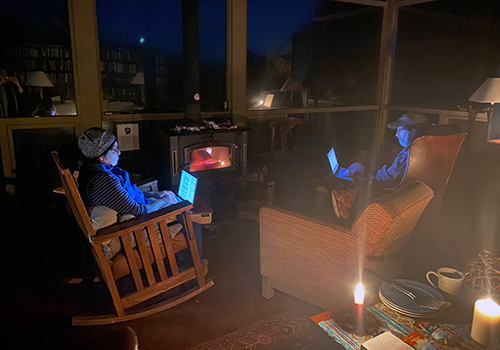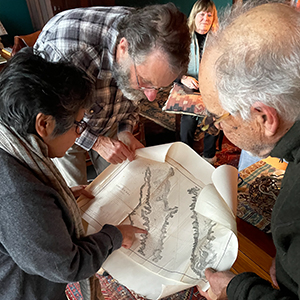Cohort Explores History and Protection of West Marin County

Our West Marin Community Fellows weathered the January storms, gathering and working by the fire. Photo: Elia Haworth.
Out here on the northern coast of California, the new year started off with a series of dramatic storms: an onslaught of rain and high winds that caused flooding, downed trees, and power outages. During this time, we hosted the 2023 West Marin Community Fellows: Elia Haworth, Theresa Harlan, and Dewey Livingston. The cohort weathered it all as they explored and wrote about West Marin County’s history and preservation—sometimes by the light and heat of the wood-burning stove.
Elia Haworth, Curator of Coastal Marin Art & History at the Bolinas Museum, focused her work during the fellowship on the town of Bolinas, including its unique natural history, indigenous people and the development and growth of the town. Elia grew up in Richland, Washington, in a semi-arid desert by the Columbia River. The desert light and open spaces were deeply influential on her life and later, her art. Elia studied art formally in college and art schools but cites world travel as her greatest education. After spending time in Europe and Asia, Elia found home when she settled in Bolinas. She has worked at the Bolinas Museum since 1999 as the Curator of Coastal Marin Art and History. She writes:
“We were distracted and interrupted by the power outage, but we three guests were harmonious and resourceful companions. While it was most useful when we could retire to our individual writing areas, our time huddled around the fire, working on our laptops, with candle light and sheets of rain hitting the windows was also special. It was a privilege to share that time with Dewey and Theresa, and to share our mutual interest in diverse aspects of Coast Marin history, as you of Mesa Refuge intended.”

Our 2023 West Marin Fellows look at an antique map of Tomales Bay with Steve Costa. Photo: Eirinie Carson.
Theresa Harlan is the founder and director of the Alliance for Felix Cove, which works to protect, restore and reclaim her Felix Family Támal-ko/Coast Miwok ancestral home in Point Reyes National Seashore. She is an advocate for landback and cultural healing for Indigenous communities. Theresa is the 2022 recipient of the Anthony Grassroots Prize of the Rose Foundation and has a long history working in the San Francisco Bay Area Native American community as an art writer, curator and consultant. She curated the traveling exhibition “Sing Me Your Story, Dance Me Home: Art and Poetry from Native California.” Emergence Magazine has a three-part podcast on her work. From Theresa:
“Ka molis for the opportunity to experience a writer’s retreat and the good company. As much as I’ve tried to protect writing, reading and rest time once home, it’s been sporadic. This tells all how valuable it is to have dedicated time to muse, digest, and contemplate. I’m looking forward towards a mutual collaboration between Mesa Refuge and the Alliance for Felix Cove.”
Dewey Livingston is a historian, archivist, mapmaker and photographer who has worked in California and Marin County for five decades. He has written extensive histories of Marin, the California Channel Islands, Death Valley and other places in the West. Dewey is currently finishing a comprehensive book on the history of Point Reyes and Tomales Bay, which he worked on during his stormy residency at Mesa Refuge, is also influenced by his own experience living in West Marin for the past 50 years. From his work during the residency, words about the history of the land on which the Mesa Refuge stands:
“Mesa Refuge is located on earth-space of the Coast Miwok, whose people walked and worked on these bluffs overlooking the Tomales Bay marshes. Quarries, stone processing areas and remains of tools and hunting weapons have been located here, telling of the lives before us.
This site was partway between the settlement called Olemaloke—current location of Olema—and Echacolom, the bayside village south of today’s Marshall. Certainly a well-used trail led from the ford at Lagunitas Creek over the bluffs of the Point Reyes Mesa, and northwest in the uplands to Echacolom.
Two hundred and fifty years ago it would not be unusual to stand on this promontory and see people in tule canoes hunting and fishing in the marsh, or the smoke of fires as the people burned grasslands and brush to tend the good land and increase the yields of seeds, acorns and game.
Imagine, for a moment, millions of birds blocking the sun as they collectively travel from the lake at Olema to the wetlands below us; those wetlands busy with sea otters darting and cavorting, scattering the fish; and look across the marsh to see what looks like a peanut shell—a grizzly dipping salmon out of the creek as those silver magicians return home to the brooks at Echatamal back of Nicasio.”
